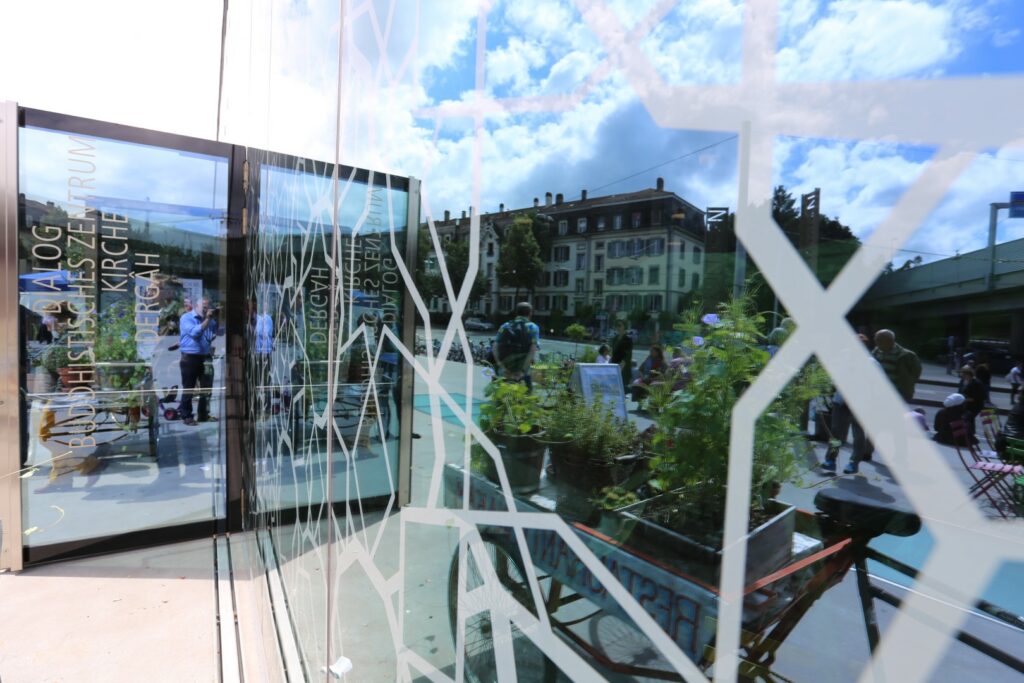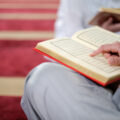The House of Religions in Bern and its key factors to success
The House of Religions in Bern and its key factors to success
The House of Religions in Bern is a huge success. It is a place where 8 different faiths are practised side by side. How was this accomplishment possible?
It sounds like a utopian dream: Alevis, Baháís, Buddhists, Christians, Hindus, Jews, Muslims, and Sikhs practising their religion in one place and living together in tolerance, respect, and peace. More than a dream, this place can be found at the Europaplatz in Bern, Switzerland. This building, the House of Religions – Dialogue of Cultures, provides sanctuaries for 5 local religious communities and an additional Dialogue section. Further, it is open to all people – religious or not.[1] [2]
The House functions as a centre for education, youth, and families, and hosts various cultural events. Moreover, it fosters integration and peaceful side-by-side living between different social groups by welcoming people with a migrant background and their traditions.[3] [4] As a ‘laboratory of coexistence’, dialogue is encouraged amongst residents and visitors regardless of religious, cultural, and linguistic differences.[5]
Places of peaceful coexistence
‘Houses of Religions’ have become increasingly fashionable within the sphere of interfaith dialogue. There are several such places of interreligious and intercultural encounters planned in Europe. A well-known project currently is the House of One in Berlin, Germany, where construction works have started this year.[6] Another example, already mentioned, is the House of Religions – Dialogue of Cultures in Bern.[7] Because its construction has been completed since 2014, the Bern House of Religions has had a significant impact on European interfaith houses.[8]
The key factors of success
Regional and international recognition of the project by journalists, politicians, and religious representatives underlines its success.[9] [10] But what paved the way to the successful implementation of the House of Religions in Bern? And what made the project thrive and attract attention? Some key success factors are as follows:
- The personal dedication of individuals was one of the main success factors. Key individuals include initiator Hartmut Haas and social scientist Gerda Hauck, who both acted as presidents of the association.[11] [12] By the intense work on public relations, it was possible to acquire famous and influential people and institutions as supporters.[13]
- Another major factor was the funding, which proved the most difficult. Concerted efforts were essential to raising 10 million Swiss francs for the new building. Struggles during this process almost sank the project. But in the end, financial support from public and private sources enabled the undertaking.[14] [15]
- Various events were organised by the association House of Religions – Dialogue of Cultures as a means to engage the community, promote the vision, and arouse the interest of potential allies.[16] The ‘Fêtes KultuRel’ and the ‘Night of Religions’ have taken place regularly since 2002. They were opportunities ‘to test cooperation among the religious communities’.[17]
- The festivities are part of another success factor – the long testing phase. Before the House of Religions was built, the association used various provisional spaces for its activities. Through this approach, the particular actors could get acquainted, establish trust, and work from a common foundation for the more comprehensive plans.[18] [19]
- Above all, the most important factor of success was the vision itself. Success was possible by giving the ambitious idea a realistic, mature, and modern shape. Additionally, patience, sticking to the vision, and dedication of all parties were prerequisites for the achievements.[20]
Unique achievements at the House of Religions in Bern
All these factors are intertwined with each other and their combination seems to be the formula of success for the initiative in Bern. After a great deal of effort, persuasion, compromises, and patience, the House of Religions – Dialogue of Cultures is now a centre of excellence for interreligious and intercultural dialogue. It gains local and international attention and many people come to visit.[21] Even such exalted personalities as the 14th Dalai Lama have stopped by.[22] Moreover, it serves as an example for other ‘Houses of Religions’ projects all over Europe.[23]
But there is still work to do in Bern. The future expenses are not fully covered right now due to the loss of a major donor.[24] Nevertheless, the initiative is already able to cover 40% of its annual budget of 1.3 million Swiss francs with its own earnings.[25]
Only time will tell what the future holds for the successful project and which extraordinary accomplishments will be made. It appears that the unique environment enables unique achievements. Attractions like the location of Bern’s first kosher and Ayurvedic restaurant within the building and the ordination of female Hindu priests are remarkable and raise high expectations for the future.[26] [27]
Want to know more about similar topics on religion and society? Go to the EARS Dashboard and get weekly updates on your selected subjects.
Sources
[1] Alfred Arm/David Leutwyler, The Process of Creation of the Bern House of Religions: Vision, Convinced Advocates, Clever Strategies, published in: Martin Rötting (Ed.), Houses of Religions. Visions, Formats and Experiences, Vienna 2021, p. 39-47.
[2] «Das Haus der Religionen ist spannend, aber keine Wohlfühloase»
[3] Heimatgefühle im Berner «Haus der Religionen»
[4] Leitbild Haus der Religionen
[5] Haus der Religionen – Idee
[6] House of One: What is driving Europe’s newest interfaith project? – EARS
[7] Haus der Religionen – Dialog der Kulturen
[8] Einzigartig: Das Haus der Religionen
[9] Arm/Leutwyler 2021, p. 47.
[10] Arm/Leutwyler 2021, p. 39.
[11] Die Weltreligionen unter einem Dach
[12] «Unser Kapital ist das gegenseitige Vertrauen»
[13] Arm/Leutwyler 2021, p. 42.
[14] Arm/Leutwyler 2021, p. 42-44.
[15] Einzigartig: Das Haus der Religionen
[16] Arm/Leutwyler 2021, p. 41, 45.
[17] Arm/Leutwyler 2021, p. 41.
[18] Arm/Leutwyler 2021, p. 39.
[19] Einzigartig: Das Haus der Religionen
[20] Arm/Leutwyler 2021, p. 45.
[21] Arm/Leutwyler 2021, p. 47.
[22] Haus der Religionen – Besuch 14 Dalai Lama
[23] Arm/Leutwyler 2021, p. 39.
[24] Arm/Leutwyler 2021, p. 46.
[25] Arm/Leutwyler 2021, p. 44.
[26] «Das war nur in Bern möglich» – Journal B
[27] Haus der Religionen in Bern – Die Konflikte der Welt bleiben nicht vor der Tür






